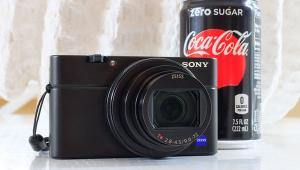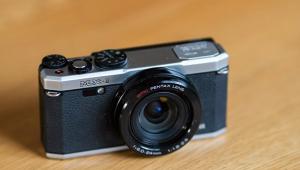The Sony Cyber-shot DSC-W200 12.1-Megapixel Pocket Camera; Taking A Fun Camera Seriously
As a photo enthusiast becomes more serious about making pictures, acquiring a larger and larger set of tools (lenses and accessories) to accommodate every possible contingency and capability seems to be essential. Unfortunately, a complex of lenses and accessories can make it all a very deliberate exercise. We all wish it could be more of a spontaneous, free-spirited adventure and not one so bogged down with gear. Wouldn't it be nice if we could just carry a little shirt pocket-sized camera around that would also produce prize-winning picture quality?
 |
|

|
|
|
When I first read the Sony press information for the Cyber-shot DSC-W200 camera
I was reminded that when I traveled a lot I used to have somewhat of a pocket
camera (big pocket), a Fuji 645 120 camera. It often came in handy when lugging
a heavy camera bag full of gear was not feasible. So, I wondered if, in this
digital age, the new Sony would be even handier (smaller pocket) and make images
one could take seriously.
Testing The Sony Cyber-shot DSC-W200
In my neighborhood the most recent and popular tourist attractions are the numerous
new wineries and vineyards, like those featured in the comedy film Sideways.
I'd never visited any of these attractions so I thought I'd do the
"wine trail" tour because at least irrigated vineyards would be
green. However, I did not think to consider that tourist attractions don't
open until mid-morning and close by 5pm at the latest, so the light at midday
in the summer would never be very flattering to the scenery. It didn't
matter all that much as most of the subjects on the "wine trail"
were not very inspiring. (It made me wonder just how the producers of the film
Sideways made their scenes so appealing and picturesque--probably by shooting
during the hours the tourists like me were not around.)
I shot subjects to test specific characteristics like color saturation and accuracy,
as well as lens distortion. For comparison I threw my Canon EOS 5D with a 28-105mm
zoom lens in a small bag to duplicate what I photographed with the Sony DSC-W200.
To ensure that each subject photographed with both cameras would be comparable,
I put my big old Gitzo tripod in the trunk of the car and made all of the shots
with both cameras on the tripod. (It's a good thing I'm a funky-looking
old man, because otherwise that cigarette pack-sized Sony DSC-W200 on a heavy
tripod would have attracted some incredulous looks.)
 |
|
|
I let both cameras determine exposure as well as color. Both were set on Auto
White Balance (AWB). In addition, I set up the shooting parameters with the
Sony to record as neutrally and normally as possible in terms of contrast and
saturation, selecting the largest image size of 12.1 megapixels. It should be
noted the Sony saves stills only in JPEG compressed format, making a file size
of about 3.5MB, or almost a 10x compression from the 34+ megabytes when opened
in Photoshop. This file size is considerably smaller than the raw, lossless
format saved by the Canon 5D. Another technical distinction is that my 5D is
set to save raw files in Adobe RGB color space, while with the Sony files are
saved in sRGB color space.
Photographing With A Very Small Camera
First of all, I must admit to cheating a bit, as sometime previous to getting
the Sony DSC-W200 I had purchased a Hoodman HoodLoupe for use with my Canon
5D, the better to see the LCD screen outside in bright sunlight. The HoodLoupe
is very much like some standard loupes designed for viewing 35mm slides, but
with a slightly larger hooded area to accommodate the size of camera LCD displays.
It has an adjustable eyepiece (ocular) to obtain precise focus on the screen.
I immediately found the HoodLoupe could be used very effectively with the Sony
DSC-W200 LCD, making it function very similarly to a Through-The-Lens SLR. It
also provided a means to hold the camera steady by having it pressed, via the
HoodLoupe, to my face to steady handheld shots. Even though the camera has an
Anti-Shake feature built-in, holding it at arm's length to see the LCD
to frame the shot, I believe, must contribute to both a degree of unsharpness
and poorly framed pictures--how can it not?
 |
|
|
Sony does have an eye-level viewfinder on the Cyber-shot DSC-W200, so you
can hold the camera close to your face for better steadiness. But like just
about every handheld camera made with an eye-level viewfinder, the area covered
by the finder frame is smaller than what is seen and recorded by the lens and
sensor. This difference, of course, assures that people photographed don't
have their heads missing by providing some "fudge" space. But the
downside for the serious user is that you can't easily fill the frame
accurately and you end up with space in your picture you may not want and have
to crop afterward in your computer.
Unlike 35mm cameras with their 24x36mm film frame size providing a 2:3 aspect
ratio, digital point-and-shoot cameras like the Sony have a frame aspect ratio
of 3:4. This makes the actual image size of a 12" print 12x16";
the Canon 5D, even with its somewhat larger megapixel count of 12.8, will reproduce
a 12x18" print. The point is that the central part of the image actually
contains about the same information, pixel for pixel, in both cameras.

















































